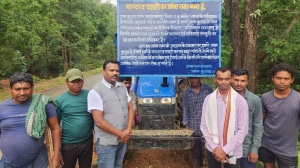History’s big chance
Turnaround moments, those that portend the untangling of political snarls created by a fractious history, emerge but rarely. The visit of Is...

Turnaround moments, those that portend the untangling of political snarls created by a fractious history, emerge but rarely. The visit of Isak Chishi Swu and Thuingaleng Muivah, the leaders of the the National Socialist Council of Nagaland — Isak-Muivah (NSCN I-M) could be one such.
It is the first engagement on Indian soil in well over three decades between the leaders of this once-banned outfit and the Indian political leadership. It marks the concluding phase of a peace process that was seven years in the making — beginning with the initial meeting in 1995 that then prime minister, P.V. Narasimha Rao, had with Swu and Muivah in Paris.
Most significantly, it represents a possible end to the country’s longest insurgency. There is, therefore, a great deal at stake here.
The message of the moment then is that while the road ahead is not free of potholes, it must be taken. New Delhi winces at terms like ‘sovereignty’, the NSCN (I-M) had traditionally found the words ‘Indian Union’ difficult to stomach, while neighbouring Manipur has demonstrated a violent antipathy to the expression ‘Greater Nagaland’, as the riots of June 2001 testify to.
Then there are other political tangles, like the internecine battles between the two factions of the NSCN — the NSCN (Khaplang) and the NSCN (I-M) — apart from the latter’s blood feud with the Kuki tribals.
All this, let it be remembered, is being played out against an election scenario, as three northeastern states — Nagaland, in which the old Congress warhorse Nagaland Chief Minister S.C. Jamir hopes to defend his citadel, Tripura and Meghalaya — go to the polls shortly.
Yet the central objective of lasting peace in the region must necessarily transcend all the other contradictions. For the Nagas, it promises an entirely new phase in their lives.
Ever since 1954, when A.Z. Phizo announced the formation of the Federal Government of Nagaland, the people have had to live with an often draconian military presence in the state. Phizo himself went into exile in the UK, but the insurgency continued despite the tentative ceasefire of 1964 and the Shillong Accord between the Assam government and the moderate Nagas.
The NSCN, particularly the NSCN (I-M) faction, held out till the mid-nineties. As for the Indian government, this is the best chance it has had in a long while to end insurgency in various pockets of the Northeast.
The NSCN (I-M) was known to have supported, trained and armed various militant groups here, including the ULFA and the All Tripura Tiger Force. If things go smoothly now many groups, not just in this region but in Kashmir and elsewhere, may be tempted to consider favourably the dialogue process.
Time, then, to move ahead for peace and nothing, perhaps, symbolises this better than the visit the two Naga leaders paid to the site at Rajghat that memorialises the nation’s greatest apostle of peace.



- 0119 hours ago
- 0218 hours ago
- 0319 hours ago
- 0419 hours ago
- 0519 hours ago




























